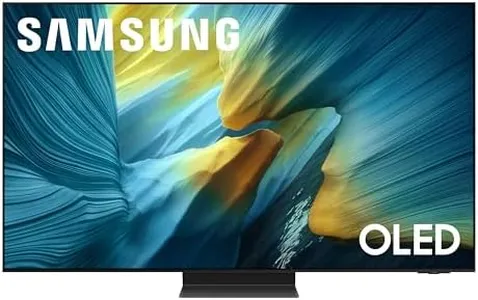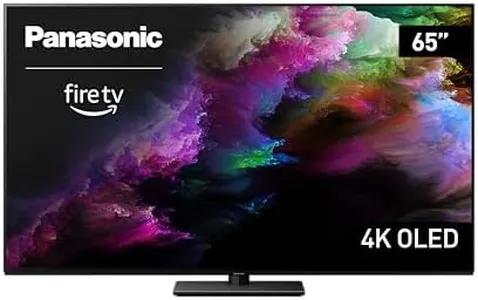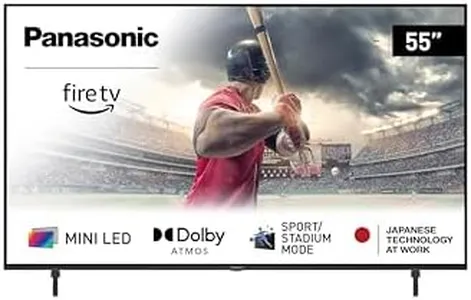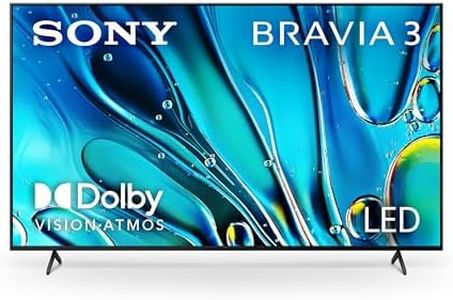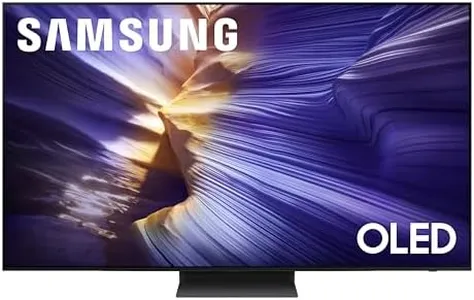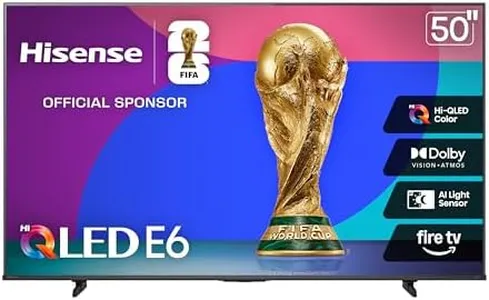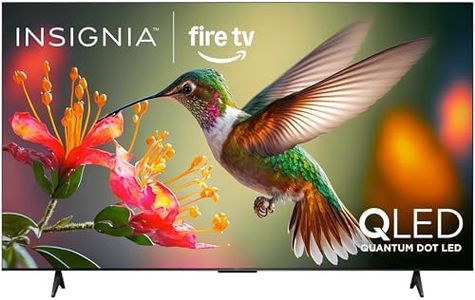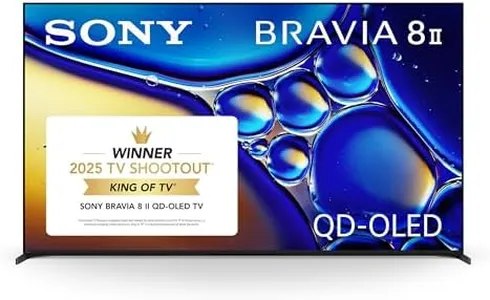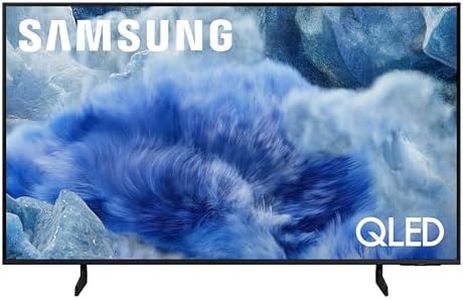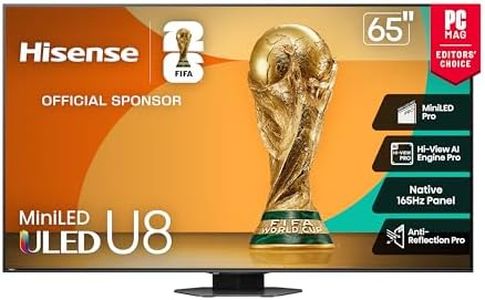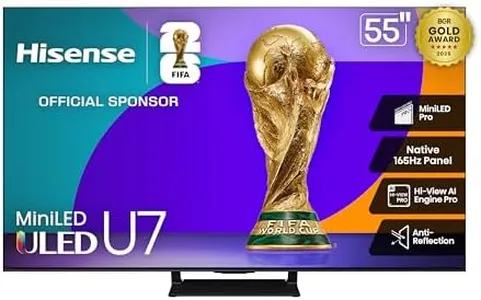Our technology thoroughly searches through the online shopping world, reviewing hundreds of sites. We then process and analyze this information, updating in real-time to bring you the latest top-rated products. This way, you always get the best and most current options available.

Our Top Picks
Winner
SAMSUNG 65-Inch Class OLED S95F 4K Glare Free Smart TV (2025 Model) NQ4 AI Gen3 Processor, OLED HDR Pro, Motion Xcelerator 164Hz, Dolby Atmos, Samsung Vision AI, Alexa Built-in
Most important from
119 reviews
The Samsung 65-Inch OLED S95F is a high-end 4K TV that shines with its stunning OLED screen offering deep blacks and vibrant colors, thanks to its pixel-level contrast and OLED HDR Pro technology. Its anti-glare feature is a standout, reducing reflections so your viewing isn't disturbed by sunlight or lamps—great for bright rooms. The TV uses Samsung’s latest AI-powered processor to enhance picture quality and sound, making everything from streaming shows to gaming look sharp and smooth.
It supports a refresh rate of 120Hz, which is excellent for sports and gaming, providing fluid motion without blur. The mention of Motion Xcelerator at 164Hz likely refers to variable refresh rate support rather than a native 164Hz panel. The built-in Dolby Atmos sound adds immersive audio, enhancing the viewing experience. Smart features include Samsung Vision AI and Alexa built-in, offering easy voice control and smart home integration. Connectivity options like Bluetooth, Wi-Fi, HDMI, Ethernet, and USB ensure you can connect various devices easily.
The TV weighs about 64 pounds and has a sleek graphite black finish, making it fairly large and substantial to handle. Priced as a premium model, it is suitable for users seeking top-tier picture quality with smart features and gaming capabilities in a large 65-inch size. For those wanting a bright, glare-free OLED TV with solid sound and smooth motion across movies, sports, and gaming, this Samsung model is a compelling choice.
Most important from
119 reviews
LG 55-Inch Class OLED evo AI 4K C5 Series Smart TV w/Dolby Atmos, Dolby Vision, HDR10, AI Super Upscaling 4K, Filmmaker Mode, Wow Orchestra, Alexa Built-in (OLED55C5PUA, 2025)
Most important from
661 reviews
The LG 55-Inch OLED evo AI 4K C5 Series is a strong choice if you want a TV with stunning picture quality and smart features. Its 55-inch OLED screen offers perfect blacks and vibrant colors thanks to over 8.3 million self-lit pixels, which makes movies and shows look very detailed and rich. The 4K resolution and HDR support, including Dolby Vision and HDR10, ensure bright and lifelike images. Thanks to LG’s Brightness Booster, it performs well even in well-lit rooms without glare distractions.
This TV is powered by the Alpha 9 AI Processor Gen8, which improves picture quality by upscaling lower-resolution content smoothly. It also includes Dolby Atmos sound technology, delivering immersive audio that complements the visuals well. The 120 Hz refresh rate and very fast 0.1ms response time make it excellent for gaming, with support for NVIDIA G-Sync, AMD FreeSync Premium, and VRR to reduce screen tearing and provide smooth gameplay.
Smart features are robust, with built-in Alexa, Google Cast, multiple voice assistants, and access to streaming apps. Connectivity options include four HDMI 2.1 ports, USB, Bluetooth, Wi-Fi, and Ethernet, giving flexibility to connect gaming consoles, soundbars, and other devices. OLED TVs like this can be more expensive than LED alternatives, and although it performs well in bright rooms, OLED screens typically excel in dimmer environments. While the sound quality is good for built-in speakers, adding a dedicated sound system might enhance the experience further. This TV is ideal for viewers who prioritize excellent picture quality, cinematic viewing, and gaming performance, making it a great pick for movie lovers and gamers who want a sleek design and smart TV capabilities in a mid-sized 55-inch screen.
Most important from
661 reviews
Panasonic Z85 Series (2024 Model) 65-inch OLED 4K Ultra HD Smart Fire TV, Dolby Vision IQ, HDR10+ Adaptive, 120Hz Refresh Rate - 65Z85AP
The Panasonic Z85 Series 65-inch OLED TV is a top-tier option for those seeking an immersive viewing experience. With a 4K Ultra HD resolution of 3840 x 2160, this TV ensures crisp and detailed images. The OLED display technology further enhances picture quality by delivering deep blacks and vibrant colors, making it ideal for movie enthusiasts who value cinematic visuals.
The 120Hz refresh rate is a strong feature, providing smooth motion which is particularly beneficial for both fast-paced sports and gaming. Speaking of gaming, the TV supports Game Mode Extreme, which includes advanced features like HDMI 2.1, VRR, AMD FreeSync Premium, and NVIDIA G-SYNC, making it a great choice for gamers looking for a responsive and immersive experience. The inclusion of Smart TV features, with Fire TV built-in, allows for easy access to streaming services and apps, enhancing the convenience of use.
Additionally, the TV supports multiple HDR formats including HDR10+, Dolby Vision IQ, and HLG, ensuring optimized picture quality that adapts to the room's lighting conditions. Audio quality is also impressive with Theater Surround Pro and Dolby Atmos, delivering a rich sound experience with clear dialogues and powerful bass. However, the TV is relatively heavy at 60.9 pounds, which may require a sturdy mount or stand. The Panasonic Z85 Series 65-inch OLED TV excels in picture and sound quality, making it a fantastic option for cinephiles and gamers alike.
Buying Guide for the Best TVs
Buying a TV can feel overwhelming given the many features and sizes, but the goal is to find one that matches your room, your viewing habits, and how you plan to use it. Start by thinking about where you'll place the TV and how far away you'll be sitting, what you like to watch most (movies, sports, gaming, channels), and the lighting in your room. Balancing these will help you choose the TV that fits you best.FAQ
Most Popular Categories Right Now
